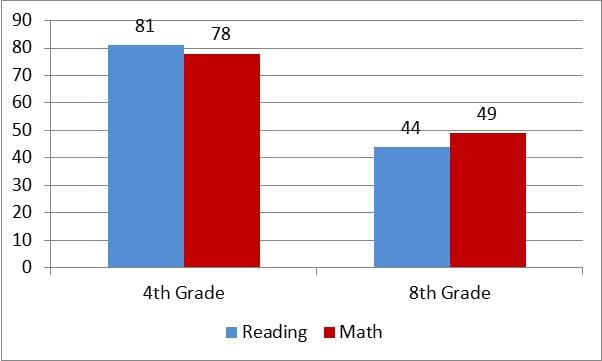The National Association of Charter School Authorizers (NACSA), a top-notch group of entities that are serious about sponsoring quality charter schools, issued a call this week for authorizers and state laws to be more proactive in closing failing schools and opening great new ones. They call it the One Million Lives campaign.
 Figure 1: Number of Ohio charter schools in the lowest 15 percent of state performance. Source: 2011-12 Ohio Report Card Results. |
At the kickoff, NACSA President Greg Richmond said, “In some places, accountability unfortunately has been part of the charter model in name only. If charters are going to succeed in helping improve public education, accountability must go from being rhetoric to reality.” He then called for a policy agenda aimed at achieving both smarter growth and stronger accountability in these ways:
- Establishing strong statewide authorizers that promote both high-quality growth and accountability,
- Writing into law standards for authorizers that are based on NACSA’s excellent Principles & Standards for Quality Charter School Authorizing,
- Placing performance expectations for charter renewal into state law,
- Empowering authorizers to close schools that fail to meet the expectations set in their charter contracts,
- Holding authorizers accountable for the performance of their schools and their authorizing practices, and
- Creating automatic school closure laws that make it impossible for education failure to persist forever.
Ohio, where Fordham is an authorizer (of eleven charters today, more tomorrow), is an excellent case in point. The Buckeye State has had more than its fair share of charter-school failures, and there is ample room for improvement in the state’s charter laws and school performance. When NACSA and Richmond speak about closing troubled schools and opening more great schools, Ohio policymakers should take heed. Ohio has dozens of charter schools in the lowest 15 percent of all statewide public-school performance in both reading and math (see figure 1).
 Figure 2: Ohio charter school closures. Since Ohio’s default-closure law took effect, it has shut down nearly as many low-performing charter schools as have authorizers on their own. |
But Ohio is also doing some things right. It was a leader in creating laws that hold authorizers accountable for the performance of their schools. Under Ohio’s charter law, approved organizations must negotiate a contract with the state to become an official authorizer.
Back in 2004, as a matter of fact, Fordham negotiated the first performance contract with the Ohio Department of Education to serve as an authorizer. Fordham, like the state’s other eighty-plus authorizers, has a contractual agreement with the department that spells out our responsibilities as an authorizer. These responsibilities include ensuring all authorized schools are in compliance with relevant state and federal laws as it relates to operational, financial, and academic performance. The performance conditions of this contract, especially with regards to holding schools accountable for their academic performance, should be strengthened. The Ohio Department of Education is, in fact, exploring ways to ramp up expectations on authorizers and their schools. But despite its limitations, the contract does give the department the authority to close truly troubled authorizers, and in recent months, one authorizer was closed for its incompetence.
Ohio was also the first state to mandate (in 2005) the automatic closure of terminally bad charter schools. The law was the result of too many authorizers failing to close persistently troubled charter schools, especially those floundering academically. The law has been modified and improved over the years. NACSA noted in their press release that almost as many charters in Ohio have been closed down by state law as have been closed by authorizers since the law took effect in 2007 (see figure 2).
Automatic closure laws are a mixed blessing, inasmuch as they let authorizers off the hook. But they do achieve the desired result: the demise of truly awful schools. Indeed, Ohio’s General Assembly is currently debating legislation that would strengthen the state’s closure requirements and extend them to “dropout recovery” charters, which are currently exempt from such laws.
Ohio is making progress out of the wilderness of charter mediocrity, but education reformers here and across the country should fully embrace the One Million Lives campaign as a way to do even more. Howard Fuller captured the spirit: “The One Million Lives initiative will not only raise the level of discourse on quality but can help build the coalition necessary to put excellence into action. Our schools, our students, and our nation will be better for it.”
